|
of California plus Baja |
||||||||||||||||||||||||||||||||||||||||||||||||
| The Habronattus diversity of California and Baja represents a potential gold mine for those interested in evolutionary diversification. One special aspect of this diversity is the prevalence of taxa showing signs of recent or ongoing diversification, as evidenced by geographical variation in various phenotypes (e.g., morphology, behavior, etc.) within what is considered to be a single species. Three examples of such patterns of variation are provided below. Although these patterns are likely the result of a complex mixture of evolutionary processes, some key processes might include sexual selection, natural selection, and hybridization. | ||||||||||||||||||||||||||||||||||||||||||||||||
|
|
||||||||||||||||||||||||||||||||||||||||||||||||
| Sexual Selection - Sexual selection, or selection based on variance in mating success, appears to be an important diversifying force in Habronattus in general. This generalization is based largely on the observation of strong sexual dimorphism, in addition to patterns of intra- and interspecific character variation. Much of this character variation is male-biased and concentrated in phenotypes which have importance in sexual signaling (e.g., courtship behaviors and associated morphological ornamentation). The Californian species H. tarsalis, and close relatives H. mustaciata and H. kawini, exemplify such character variation (photos below). Note the differences in scale patterning of the chelicerae (jaws), the scale color and swelling of the clypeus (area below the large eyes), and development of leg I fringes. All of these characters are prominently displayed during courtship, which also varies both within and between these species. | ||||||||||||||||||||||||||||||||||||||||||||||||
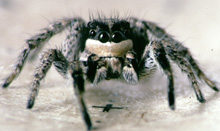 |
||||||||||||||||||||||||||||||||||||||||||||||||
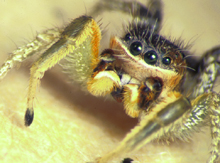 |
||||||||||||||||||||||||||||||||||||||||||||||||
| H. tarsalis - northern CA | ||||||||||||||||||||||||||||||||||||||||||||||||
 |
||||||||||||||||||||||||||||||||||||||||||||||||
| H. mustaciata - northern CA | ||||||||||||||||||||||||||||||||||||||||||||||||
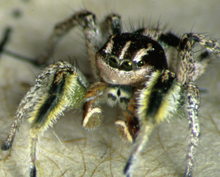 |
||||||||||||||||||||||||||||||||||||||||||||||||
| H. tarsalis - eastern CA | ||||||||||||||||||||||||||||||||||||||||||||||||
 |
||||||||||||||||||||||||||||||||||||||||||||||||
| H. kawini - northern Baja | ||||||||||||||||||||||||||||||||||||||||||||||||
| H. tarsalis - northern Baja | ||||||||||||||||||||||||||||||||||||||||||||||||
|
|
||||||||||||||||||||||||||||||||||||||||||||||||
| Substrate Matching? - Not all California examples of geographical variation can be tied solely to sexual selection. At least one species, H. ustulatus, shows patterns of geographical variation consistent with strong natural selection. This pattern was first noted by Griswold, who wrote that H. ustulatus "includes small, terrestrial spiders which appear to exhibit local variation in color and markings correlated with the color and pattern of the substrate". H. ustulatus, in preferring "structurally simple" microhabitats (e.g., open ground, dunes), has a natural history consistent with selection for crypsis. Furthermore, the photos below provide suggestive evidence for such selection, with rather obvious differences across populations in dorsal coloration. However, actual studies are needed to document the ecological and evolutionary basis for these patterns. | ||||||||||||||||||||||||||||||||||||||||||||||||
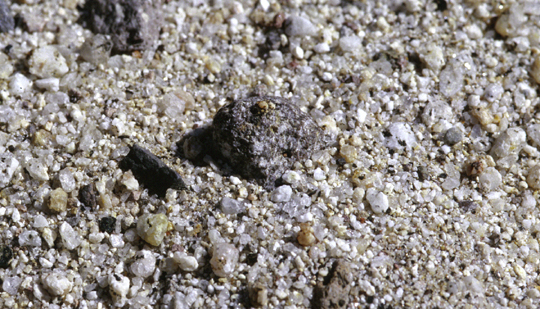 |
||||||||||||||||||||||||||||||||||||||||||||||||
| H. ustulatus in habitat. El Berrendo Canyon, B.C.N. | ||||||||||||||||||||||||||||||||||||||||||||||||
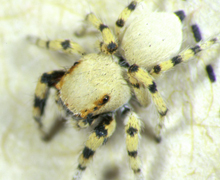 |
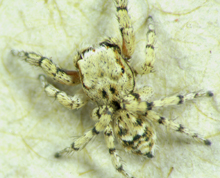 |
|||||||||||||||||||||||||||||||||||||||||||||||
| central Baja dune fields | ||||||||||||||||||||||||||||||||||||||||||||||||
| northern Baja canyon wash | ||||||||||||||||||||||||||||||||||||||||||||||||
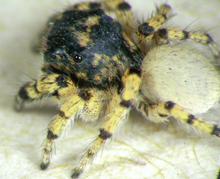 |
 |
|||||||||||||||||||||||||||||||||||||||||||||||
| central Baja desert flats | ||||||||||||||||||||||||||||||||||||||||||||||||
| southern CA canyon wash | ||||||||||||||||||||||||||||||||||||||||||||||||
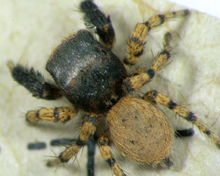 |
||||||||||||||||||||||||||||||||||||||||||||||||
| southern CA chaparral | ||||||||||||||||||||||||||||||||||||||||||||||||
|
|
||||||||||||||||||||||||||||||||||||||||||||||||
| Hybridization - Several Habronattus populations showing signs of hybridization are known from California, most involving members of the H. americanus group. The photographs below provide an example of such hypothesized hybridization between the species H. americanus and H. sansoni. All individuals shown were collected from the same high-elevation site in northern CA. Although not measured, no obvious microhabitat differences were noted. The sample includes animals which might be considered "typical" for both species, plus animals revealing a mix of characteristics. Study of such populations is expected to provide insight into processes which promote diversification. | ||||||||||||||||||||||||||||||||||||||||||||||||
| Close to "typical" H. sansoni, with a narrow face, "low" banded clypeal iridescence, dark unmarked leg I, yellow-white palps, yellow chelicerae. |
||||||||||||||||||||||||||||||||||||||||||||||||
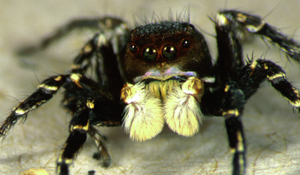 |
||||||||||||||||||||||||||||||||||||||||||||||||
 |
||||||||||||||||||||||||||||||||||||||||||||||||
| With yellow-white palps and chelicerae much like sansoni, but with a high iridescent clypeus and striped legs of americanus. | ||||||||||||||||||||||||||||||||||||||||||||||||
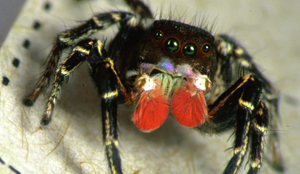 |
||||||||||||||||||||||||||||||||||||||||||||||||
| With a "sansoni - like" clypeus and yellowish chelicerae, but otherwise like americanus. | ||||||||||||||||||||||||||||||||||||||||||||||||
 |
||||||||||||||||||||||||||||||||||||||||||||||||
| With a low clypeus, but some swelling evident. Also, white edges of palps from sansoni? | ||||||||||||||||||||||||||||||||||||||||||||||||
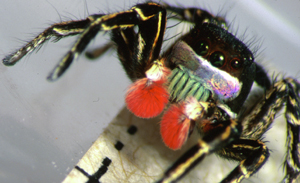 |
||||||||||||||||||||||||||||||||||||||||||||||||
| Close to "typical" H. americanus, with a swollen face, "high" unbanded clypeal iridescence, striped leg I, red palps, white chelicerae. |
||||||||||||||||||||||||||||||||||||||||||||||||